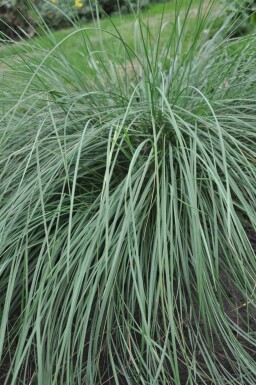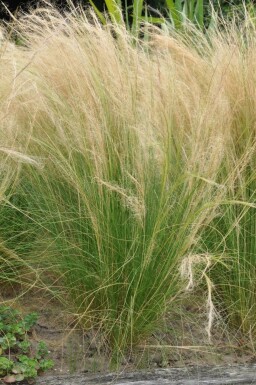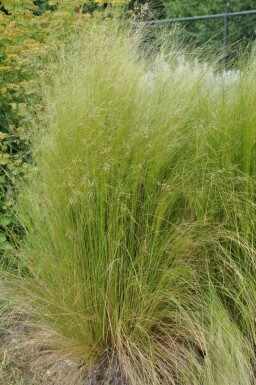

200cm



Heijnen Plants is delighted to present the graceful Stipa, commonly referred to as feather grass or needlegrass. This elegant plant is renowned for its delicate and fine-textured foliage that sways beautifully in the breeze. Stipa species are characterized by their slender leaves of a lush green hue and inflorescences that display an array of colors, from the warm tones of brown and yellow to the subtle hints of green and white. This ornamental grass is a superb choice for adding a touch of softness and movement to any garden design, creating a serene and natural aesthetic that is pleasing to the eye.


200cm












50cm



The genus Stipa, commonly known as feather grass or needlegrass, comprises a charming collection of ornamental grasses that are renowned for their slender, cascading foliage and airy inflorescences which dance in the breeze. These grasses are highly versatile and can be employed in a variety of garden settings, from borders and group plantings to solitary statement pieces or even thriving in pots and planters.
Feather grasses are sought after for their ease of care and their ability to thrive in a broad spectrum of soil types, provided the soil is well-drained. Their preference for sun to partial shade makes them adaptable to various garden aspects, where they contribute texture and movement throughout their long flowering period from June to August.
The alluring dance of Stipa grasses in the gentle breeze brings serene movement to any garden. These ornamental grasses, known for their feathery plumes and elegant, fine leaves, offer a texture and grace to landscapes that few other plants can match. With varieties ranging in size from the majestic Stipa gigantea to the delicate Stipa tenuissima 'Ponytails', there is a perfect Stipa for every garden design.
We would like to provide some tips on how to plant and care for a Stipa. By following these tips, you can be sure to enjoy your Stipa for a long time.
For optimal growth, Stipa thrives in a location that receives full sun to partial shade. However, to truly flourish and display its characteristic flowing beauty, a sunny spot is preferable. The grass is adaptable to various soil types, provided they are well-drained, ensuring that its roots do not sit in waterlogged conditions. A moderately watered regime is sufficient, as the plant has average water needs. A position that offers ample light will enhance the striking colors of its foliage and feathery blooms, particularly during the summer and autumn months when they transition into a captivating display of gold.
For successful establishment, it is essential that Stipa is planted in well-drained soil, as this species thrives across various soil types. The ideal planting period spans from spring to autumn, avoiding extremes in temperature. Once positioned in a location that receives full sun to partial shade, the plant should be watered regularly, ensuring average moisture levels are maintained to support growth. During the initial stages post-planting, care should be taken to provide adequate water to encourage strong root development, allowing the species to become well-established in its new environment.
Fertilizing Stipa species should be approached with a light hand, as they are generally undemanding in terms of nutrition. A balanced, slow-release fertilizer applied in the spring can provide adequate nutrients throughout the growing season. This gentle approach ensures the plant has access to essential nutrients without promoting excessive growth that can compromise its delicate structure and natural form.
As Stipa thrives in well-drained soils and is accustomed to less fertile conditions, over-fertilization can do more harm than good, leading to lush but weak growth. Therefore, stick to minimal applications; this not only supports the health of the plant but also helps in maintaining the graceful, feathery plumes that are characteristic of these ornamental grasses.
Pruning of Stipa species is a straightforward task that enhances their graceful form. In late winter or early spring, before new growth begins, trim the plant back to remove any dead or discolored foliage and spent flower stalks from the previous season. This tidy-up encourages healthy, fresh growth and maintains the plant's natural, flowing shape. Use clean, sharp tools to make precise cuts, avoiding any damage to the plant's crown or new shoots that may be emerging.
Stipa species thrive with moderate watering routines, ensuring the soil remains well-drained. Overwatering or allowing the roots to sit in water can be detrimental, so it is vital to strike a balance. During the establishment period, regular watering supports healthy growth. Once established, these resilient grasses can tolerate some dry spells. Watering should be done deeply and infrequently, encouraging strong root systems that reach deep into the soil for moisture. In pots or planters, be mindful to check soil moisture levels more frequently, as these can dry out faster than garden soils.
Stipa, often admired for its delicate, feathery plumes, is an asset to any garden, providing an ethereal quality with its graceful movement in the breeze. Its fine texture serves as an excellent contrast against broader-leaved plants, offering a dynamic visual interplay. When potted, this grass benefits from a well-drained substrate to encourage healthy growth. As it sways through the seasons, Stipa captures the light differently, creating a captivating display that evolves from dawn to dusk.
Dividing Stipa species is an essential practice for maintaining plant vigor and encouraging robust new growth. It is most effective when carried out during the cooler temperatures of spring or autumn. To propagate, carefully remove the plant from the soil, ensuring minimal disturbance to the roots. Once extracted, gently separate the clump into smaller sections. Each division should have a healthy supply of roots and shoots to ensure successful replanting. Replant the sections at the same depth they were originally growing to promote optimal development. This division process helps to rejuvenate the plants and sustain their graceful, flowing aesthetic in the garden.
Elevate your landscape with the graceful Stipa, a genus that adds a touch of elegance with its fine, feathery plumes. These ornamental grasses sway beautifully in the breeze, creating a serene and inviting garden atmosphere. Ideal for softening hard edges and adding texture, Stipa is an exquisite choice for any garden aficionado.
